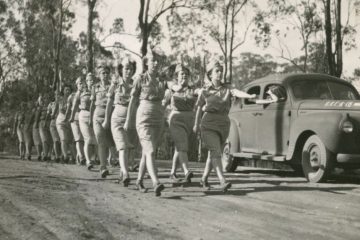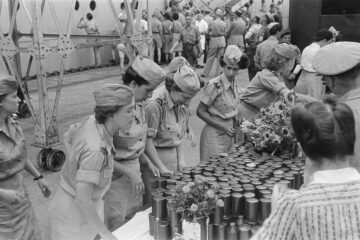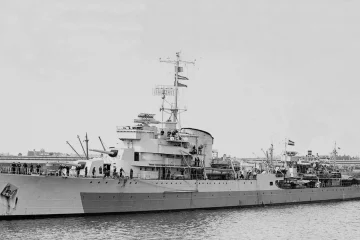Born as Maria Louisa Frederika, “Darja” Collin (November 19, 1902 – May 6, 1967) was a Dutch ballet dancer and classical ballet teacher.
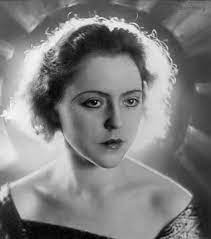
She had been trained in classical ballet (studying under Preobrajenska and Trefilova), and also in Mary Wigman’s school. She was also influenced by the famous American/Russian dancer Isadora Duncan (1877-1927). She in turn was very much influenced by the German philosopher Friedrich Nietzsche. He encouraged people to think for themselves, be free spirits and to follow their own Will to Power. These new dancers broke with traditional ballet and were among the first free spirits, dancing barefoot and often in Greek inspired tunics that were loose-fitting and often see-through.
Collin was a famous dancer in the 1920s and had nicknames such as ‘The Mata Hari of dance’ and ‘Moon Goddess’. Collin broke through in the Netherlands in 1928. She was known as the first actress with ‘star allures’. She was recognised as such throughout Europe. In 1933 she opened her own dance school in The Hague.
In 1937 as well as in June 1941 Darja and her co-dancer Edmee Monod toured Netherlands East Indies (NEI). An article in the Sumatra Post shows that in November that year she was still in NEI.
According to the article below she escaped several theatres of war – together with Edmee – before arriving in Australia. Here she changed her name into Darya.
Born as Melanie Edmee Monod de Froideville was born on 20-12-1909 in Semarang, Central Java. She married, at the age of 40 years, in 1949 in Melbourne Donald Alan Cameron, aged 49 years. Esmee died in Launceston in 1999.
Dutch dancers kept escaping the frontlines – ‘Now in Australia’ 18 July 1942
| ‘Two young Dutch girls, dancers, got out of France ahead of the Germans; dodged out of a political cobweb in Africa’s Vichy- French Congo; escaped from Java ahead of the storming Japanese. Taking refuge in Australia, Darya Collin and Edmee Monod de Froideviile will give a dance recital for the Red Cross in Sydney shortly. Dancers were in Nice when Nazis plunged through the Low Countries. For many days, the girls searched for their families in stream of Dutch, Belgian and French fugitives. Resolving to return to Netherlands East Indies, they went to Marseilles. “In that bombed city, they waited anxiously for an exit permit, found passage on a ship as France’s fate was sealed. When the little ship, Jean Laborde, was within 36 hours of Cape Town, France capitulated, and her Vichy-minded captain turned back to Pointe Noire, French Congo. For 2 ½ months, the girls lived aboard ship, on scant rations (including bread made from sweet potato flour), until Dutch consul in Belgian Congo arranged passage to South Africa. They arrived at Batavia on December 17, 1941. By February 21 they were again fleeing, on ship no bigger than a harbor ferry. On this miserable escape ship, they lived and slept on crowded deck, limited to one glass of water daily and one cup of tea or coffee twice daily. After 10 days, they reached Freemantle, having gone through Sunda Strait In their flat in Elizabeth-street, Sydney, the girls unpack their precious wardrobe basket. They jealously preserved their stage costumes during adventures, though losing most of their ordinary clothes. Source Trove |
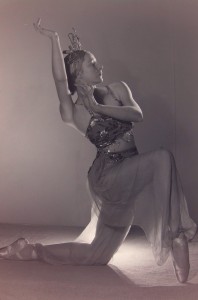
During WWII she established the Darya Collin Dance Troupe with Edmee Monod and Alison Lee. She performed for Dutch, American, and British troops. Alison Lee (stage name Helene Lineva) became later a ballerina at the Victorian Ballet.
There were two more partners. Audrey Barron, a young pianist from Western Australia and Elaine Haxton the Troupe’s costume designer.
At that time three of them lived at 17 Rosemont Av in Edgecliffe, Sydney, Allison lived in Willoughby and Elaine at Potts Point.
Australia
The Bulletin 11- August 1943- Women’s Letters From Sydney and Melbourne (Abstract)
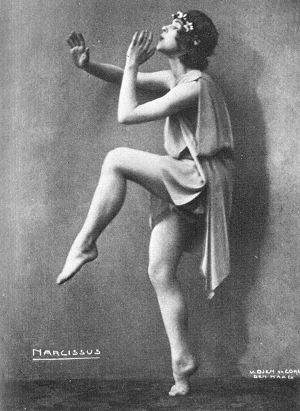
Sydney
Last Thursday morning in the ballroom of Merioola Dutch dancers Darya Collin and Edmee Monod held rehearsal of the new dances they have arranged for their recital in aid of the Red Cross. New costumes for the dances have been designed by artist Elaine Haxton and are very light and gay. Ballerina Tchinarova fashioned them, and she and Elaine are pleased with the results, though tracking down the fabrics and shades required amid depleted war-time stocks had them now and then almost in despair.
Of the four or five costumes designed for Edmee that for “The Little Turk” (music by Mozart) met the flashing gaze of admiration last week. Its draped pink trousers are topped by a black-and-white jacket, the sleeves lined with lime-green. Darya, who has a fine array of her costumes from Paris, has only one new creation.
This is for her Danse Exotique (Erik Satie), which will probably appear on the programme as “The Flower Dance.” It is inspired by a Sumatran ceremonial in which native girls make great play with candles. Darya replaces the candles with two great and burning hibiscus blossoms. Audrey Barron, Westralian pianist of 19 or so, will make her first appearance in Sydney as the team’s soloist and accompanist. The first performance will be given on August 18 at the Con. Lord and Lady Gowrie and Lord and Lady Wakehurst will be in the audience.
Second performance at the same address will be on August 26. After these recitals the dancers will go to Melbourne to open a season arranged by J. C. Williamson.
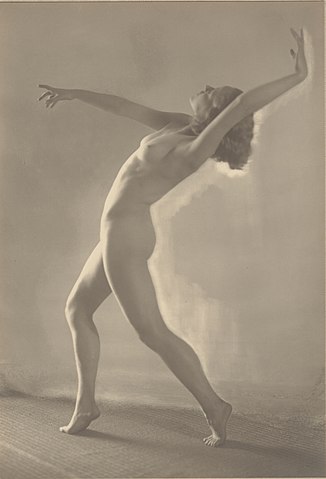
Melbourne
Under the guidance of Harold Clapp’s (1) lady plans are well in hand for the presentation of Dutch dancers Darya Collin and Edmee Monod for the first time in this city.
Red Cross funds will reap the financial rewards of the show, which will be staged at the Comedy on September 7. The two describe their sphere as “synthetic ballet,” a term which has significance in Europe but is new to local balletomanes.
Apparently, the idea is a blending of the classical and the modern. Valerie Purves is attending to radio publicity, and the Dutch community is giving its help, too, under the leadership of the Baroness von Aersen.
Netherlanders have an enviable reputation with organisers of aid for good causes in this city. They still give enthusiastic support and show a great willingness to put shoulders to the wheel on behalf of any community effort, though they have their own service men to think of in these times. The Baroness von Aersen, wife of the Netherlands Minister, is a well-known figure at all patriotic cause gatherings and much in demand as a speaker at social functions. Melbourne will miss her when the Dutch Legation takes up its quarters in Canberra.
According to an article in Sydney’s Wireless Weekly from 5 September 1942:
Darja dances with fluency and expressiveness. Most of her items required more interpretive than technical skill, and she was at her best in “L’ldole,” an Eastern dance, and “Potiphar’s Wife.” She rose well to the varying moods of each dance. Edmee Monod danced with grace and vivacity.
WWII – Touring Allied troops
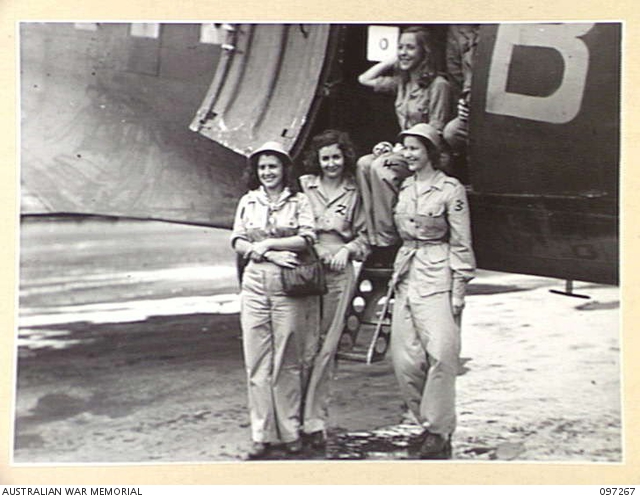
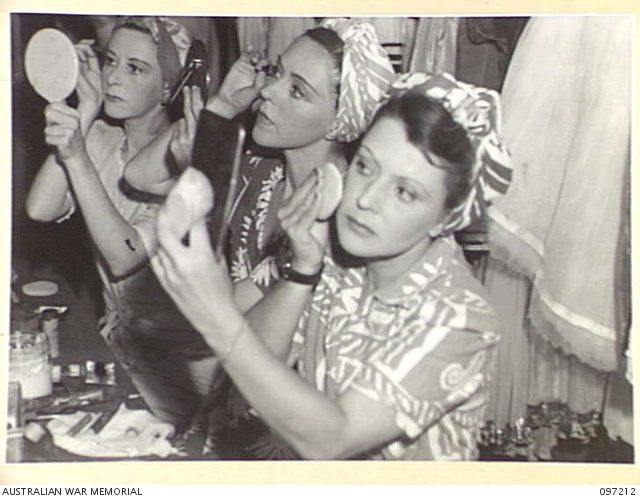

Diplomatic incident
Their war time travels also led to a minor diplomatic incident between Australia and the Netherlands. In March 1945 the five women had left from Archerfield Airport, Brisbane to Merauke in Dutch New Guinea to entertain the troops.
The Australian Director-General of Security noted in May 1945 that the three women had travelled without passports and exit permits. When questioned at Archerfield the Dutch Liaison Office had stated that they were three ‘Dutch Army Nurses’. When interrogated on their return the security note states that ‘The story was a complete falsehood’.
The Deputy Director of Security of Queensland was ordered to inform the Dutch authorities that they will no longer be permitted to proceed to Dutch New Guinea unless they are in the possession of passports and exit permits. (Source Documents in the National Archives of Australia)
Paul Budde December 2021
Footnotes
- Herald Clapp was in May 1939, with the outbreak of World War II imminent, seconded by then Prime Minister Robert Menzies to become general manager of the Aircraft Construction Branch of the Commonwealth Department of Supply and Development, overseeing the construction of Bristol Beaufort bombers in Australia. He was made chairman of the new Aircraft Production Commission in March the following year.
- Baroness van Aerssen (Ima Annioeta Barones van Asbeck) was the wife of Baron Francois Cornelis van Aerssen Beijeren van Voshol (who was the Netherlands Ambassador in Australia from 1942 1947).
